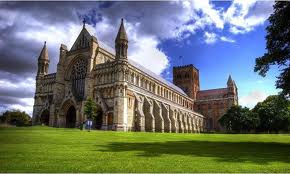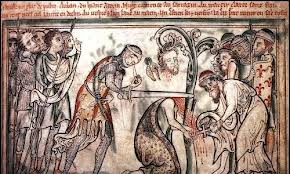
Saint Alban was the first British Christian martyr and one of three martyrs remembered from Roman Britain. The story says Alban was a Romano-British citizen in the Roman town of Verulamium (now St. Albans), probably at the end of the third century. He gave shelter to an itinerant Christian priest who Geoffrey of Monmouth names Amphibalus. While the priest stayed with Alban, he converted him to Christianity. The Emperor then started a program of persecution and soldiers came in search of the priest. Alban changed cloaks with the priest, allowing him escape. Alban was arrested in his place.
Alban was put on trial. He bravely swore to his newfound faith. When the judge learned he had impersonated the priest he ordered him punished as if he were the priest. Alban was condemned to death. He was led out of the city, across a river and up a hillside where he was beheaded. A church was built on the site of the martyrdom. There is a record of St. Germanus visiting the shrine c. 429. Bede recounted the story in his writings in the eighth century and mentioned there was a church and shrine there. Pilgrims were travelling there and it became a place of healing. The thirteenth century chronicler Matthew Paris claimed the Saxons destroyed this building in 586.

King Offa of Mercia founded a Benedictine abbey and monastery on the spot in 793 and it was to rank as the premier abbey in England. This abbey was probably sacked by the Danes around 890 and the office of abbot was to remain empty from about 920 to the 970’s. Efforts to revive the Saxon abbey were stalled when more Viking raids persisted from 1016. A great Norman stone abbey was begun in 1077. Construction was completed in 1089 but the building was not consecrated until 1115. King Henry I and other nobles attended. The tower was a distinct feature of the building and it is the only eleventh century great crossing tower still standing in England.
The abbey was extended in the 1190’s. The new additions were of Gothic architecture. A more prominent shrine and altar to St. Amphibalus were added. An earthquake did damage to the eastern end of the church in 1250. Some of the cracked sections of the building were knocked down in 1257. More rebuilding and updating occurred from 1263 to 1290. St. Alban’s tomb was restored at this time. On October 10, 1323, two piers on the south side of the nave collapsed, dragging down much of the roof and wrecking five bays. The new mason matched the Early English style of the rest of the building but also added fourteenth century detailing and ornaments.

More detail work was done in the fifteenth century but from 1521 on the building fell into disrepair and decay. The abbey was surrendered on 1539 during the Dissolution of the Monasteries and everything was stripped bare. The town and archdeacon were able to get irregular funds to help repair the building. King James I gave a royal gift in 1612. Money for repairs dried up during the English Civil War and the abbey was used to hold prisoners of war and suffered vandalism. Dilapidation was so severe by the end of the seventeenth century, the building barely survived demolition.

From that point on, many forces have worked to raise funds, redesign, demolish and restore the building down to this very day. St. Alban was given cathedral status by the church in 1877. The building remains of mixture of Early English, Norman, Gothic, Perpendicular and Victorian architecture.
Very interesting.
LikeLike
I grew up in Hatfield, not far from St Albans and always loved visiting the cathedral and Verulamium – it is in the park and there is also the remains of an ampitheatre too, and there used to be a small museum which I think has been expanded now. I enjoyed revisiting the cathedral through your post.
LikeLiked by 1 person
[…] I love that Susan Abernethy puts so much of her time and devotion in to researching and writing historical pieces! As someone who also studied history in university who isn’t directly using her degrees after, I look forward to each and every one of her posts. A medieval historian isn’t overly easy to find, especially not one as talented and insightful as Susan. The fact that she also loves royalty doesn’t hurt at all! Favourite Posts? Mary, Queen of Scots and St. Albans Cathedral! […]
LikeLike
Thank you for this! I lived in Harpenden, near St. Albans, when I was a kid, and I remember going to this cathedral, but as is often the case with things so close to me, it often doesn’t occur to me to learn more. I wish I could revisit with your post in hand! (And your mention of Verulamium brought back memories of running around on the ruins – wonder if people are still allowed to do that?)
LikeLike
HaHa! I wonder if you could still run around the ruins too. Do you know what town Verulamium is now? This cathedral has survived a lot.
LikeLike
Just looked at some pictures online — looks like it’s a park in St. Albans now!
LikeLike
Hello Susan your post have a lot of interesting source for learn about that cathedral, incredible!!!!!
LikeLike
Thank you Princess! 🙂
LikeLike
Thanks for reading la dauphine. Yes this is an old one and was almost demolished! It’s really amazing it’s still standing.
LikeLike
Wow! That is a really old cathedral…pre-Norman Conquest! I’m really enjoying these cathedral posts. Thank you!
LikeLike